Scale-Dependent Controls on Landslide Susceptibility in Angra dos Reis (Brazil) Revealed by Spatial Regression and Autocorrelation Analyses
Abstract
1. Introduction
2. Materials and Methods
2.1. Study Site
2.2. Landslide Inventory and Prediction Locations
2.3. Pre-Selected Predictor Variables
2.4. Multicollinearity and Feature Selection
2.5. Selected Predictor Variables
2.6. Spatial Autocorrelation Analysis (LISA)
2.7. MGWR Modeling
2.8. Model Validation and Performance Metrics
3. Results
3.1. Rainfall Patterns
3.2. Multivariate Analysis of Explanatory Variables
3.3. Spatial Autocorrelation of Landslide Frequency Ratio
3.4. MGWR Model Diagnostics and Performance
4. Discussion
4.1. Spatial Structure and Autocorrelation of Landslide Susceptibility
4.2. Influence of Topography and Rainfall on Landslide Susceptibility
4.3. Spatial Non-Stationarity and the Role of MGWR
4.4. Lithology, Land Use, and Connectivity Effects
4.5. Roads and Infrastructure as Persistent Triggers
4.6. Implications and Limitations
5. Conclusions
Author Contributions
Funding
Institutional Review Board Statement
Informed Consent Statement
Data Availability Statement
Acknowledgments
Conflicts of Interest
References
- Coelho-Netto, A.L.; de Souza Avelar, A.; Lacerda, W.A. Landslides and disasters in Southeastern and Southern Brazil. Dev. Earth Surf. Process. 2009, 13, 223–243. [Google Scholar] [CrossRef]
- de Souza, L.J.; Guimarães, R.F.; da Silva, F.B. Landslides zonation hazard: Relation between geological structures and landslides occurrence in hilly tropical regions of Brazil. An. Acad. Bras. Ciências 2017, 89, 2809–2820. [Google Scholar] [CrossRef]
- Marengo, J.A.; Cunha, A.P.; Seluchi, M.E.; Camarinha, P.I.; Dolif, G.; Sperling, V.B.; Alcântara, E.H.; Ramos, A.M.; Andrade, M.M.; Stabile, R.A.; et al. Heavy rains and hydrogeological disasters on February 18th–19th, 2023, in the city of São Sebastião, São Paulo, Brazil: From meteorological causes to early warnings. Nat. Hazards 2024, 120, 7997–8024. [Google Scholar] [CrossRef]
- Alcântara, E.; Baião, C.F.; Guimarães, Y.C.; Mantovani, J.R.; Marengo, J.A. Machine learning approaches for mapping and predicting landslide-prone areas in São Sebastião (Southeast Brazil). Nat. Hazards Res. 2025, 5, 247–261. [Google Scholar] [CrossRef]
- Da Silva, E.J.R.; Alves, C.N.; de Oliveira Campos, P.C.; Costa e Oliveira, R.A.A.; Marques, M.E.S.; Amorim, J.C.C.; Paz, I. Comparison of Rain Gauge Network and Weather Radar Data: Case Study in Angra dos Reis, Brazil. Water 2022, 14, 3944. [Google Scholar] [CrossRef]
- Manfré, L.A.; Albuquerque, N.G.; Quintanilha, J.A. Landslide hazard mapping near the Admiral Álvaro Alberto Nuclear Complex, Rio de Janeiro, Brazil: Mapping the landslide risk associated with the Admiral Álvaro Alberto Nuclear Complex, Rio de Janeiro, Brazil. Bol. Ciências Geodésicas 2018, 24, e20180009. [Google Scholar] [CrossRef]
- Chowdhury, M.S.; Rahman, M.N.; Sheikh, M.S.; Sayeid, M.A.; Mahmud, K.H.; Hafsa, B. GIS-based landslide susceptibility mapping using logistic regression, random forest and decision and regression tree models in Chattogram District, Bangladesh. Heliyon 2023, 10, e23424. [Google Scholar] [CrossRef]
- Nhu, V.-H.; Mohammadi, A.; Shahabi, H.; Ahmad, B.B.; Al-Ansari, N.; Shirzadi, A.; Clague, J.; Jaafari, A.; Chen, W.; Nguyen, H. Landslide susceptibility mapping using machine learning algorithms and remote sensing data in a tropical environment. Int. J. Environ. Res. Public Health 2020, 17, 4933. [Google Scholar] [CrossRef]
- Reichenbach, P.; Rossi, M.; Malamud, B.D.; Mihir, M.; Guzzetti, F. A review of statistically-based landslide susceptibility models. Earth-Sci. Rev. 2018, 180, 60–91. [Google Scholar] [CrossRef]
- Van Westen, C.J.; Castellanos, E.; Kuriakose, S.L. Spatial data for landslide susceptibility, hazard, and vulnerability assessment: An overview. Eng. Geol. 2008, 102, 112–131. [Google Scholar] [CrossRef]
- Baião, C.F.; Mantovani, J.; Alcântara, E. Increasing landslide susceptibility in urbanized areas of Petrópolis identified through spatio-temporal analysis. J. South Am. Earth Sci. 2025, 160, 105509. [Google Scholar] [CrossRef]
- Fotheringham, A.S.; Brunsdon, C.; Charlton, M. Geographically Weighted Regression: The Analysis of Spatially Varying Relationships; John Wiley & Sons: Hoboken, NJ, USA, 2002. [Google Scholar]
- Park, S.; Kim, J. A comparative analysis of landslide susceptibility assessment by using global and spatial regression methods in Inje area, Korea. J. Korean Soc. Surv. Geod. Photogramm. Cartogr. 2015, 33, 579–590. [Google Scholar] [CrossRef][Green Version]
- Wee, S.J.; Park, E.; Alcântara, E.; Lee, J.S.H. Exploring multi-driver influences on Indonesia’s biomass fire patterns from 2002 to 2019 through geographically weighted regression. J. Geovisualization Spat. Anal. 2024, 8, 4. [Google Scholar] [CrossRef]
- Zhang, H.; Wang, Z. Human activities and natural geographical environment and their interactive effects on sudden geologic hazard: A perspective of macro-scale and spatial statistical analysis. Appl. Geogr. 2022, 143, 102711. [Google Scholar] [CrossRef]
- Zhao, Z.; Xu, Z.; Hu, C.; Wang, K.; Ding, X. Geographically weighted neural network considering spatial heterogeneity for landslide susceptibility mapping: A case study of Yichang City, China. Catena 2024, 234, 107590. [Google Scholar] [CrossRef]
- Lin, Y.; Zhang, F.; Jin, Y.; Wen, L.; Yu, Y.; Zhang, L.; Weng, A.; Ge, Y. Spatial non-stationarity effects of the driving factors on landscape ecological risk: A case of the Xiamen-Zhangzhou-Quanzhou Urban Agglomeration, China. Ecol. Indic. 2024, 167, 112660. [Google Scholar] [CrossRef]
- Goetz, J.N.; Guthrie, R.H.; Brenning, A. Integrating physical and empirical landslide susceptibility models using generalized additive models. Geomorphology 2011, 129, 376–386. [Google Scholar] [CrossRef]
- Guerra, A.J.T.; Bezerra, J.F.R.; do Carmo Oliveira Jorge, M.; Fullen, M.A. The geomorphology of Angra dos Reis and Paraty municipalities, southern Rio de Janeiro state. Rev. Geonorte 2013, 4, 1–21. [Google Scholar]
- Soares, F.S.; Francisco, C.N.; Senna, M.C.A. Spatial and temporal distribution of precipitation in the Ilha Grande Bay Hydrographic Region—Rio de Janeiro. Rev. Bras. Meteorol. 2014, 29, 125–138. Available online: https://www.scielo.br/j/rbmet/a/kbBKVCpC5C7ChCRcd9zfPhg/ (accessed on 2 May 2025). [CrossRef]
- Germain, D.; Roy, S.; Jose Teixera Guerra, A. Empirical Rainfall Thresholds for Landslide Occurrence in Serra do Mar, Angra dos Reis, Brazil; IntechOpen: London, UK, 2022. [Google Scholar] [CrossRef]
- de Mendonça, M.B.; Gullo, F.T. Landslide risk perception survey in Angra dos Reis (Rio de Janeiro, southeastern Brazil): A contribution to support planning of non-structural measures. Land Use Policy 2020, 91, 104415. [Google Scholar] [CrossRef]
- Mantovani, J.R.; Bueno, G.T.; Alcântara, E.; Park, E.; Cunha, A.P.; Londe, L.; Massi, K.; Marengo, J.A. Novel Landslide Susceptibility Mapping Based on Multi-criteria Decision-Making in Ouro Preto, Brazil. J. Geovisualization Spat. Anal. 2023, 7, 7. [Google Scholar] [CrossRef]
- CPRM—Serviço Geológico do Brasil. Relatório de Setorização de Risco: Angra dos Reis—RJ; CPRM: Rio de Janeiro, Brasil, 2011. Available online: https://rigeo.cprm.gov.br/handle/doc/23738 (accessed on 9 April 2025).
- Machado, J.C.B., Jr. Percepção de Risco em Desastres Naturais: Um Estudo de Caso em Áreas já Afetadas no Município de Angra dos Reis. Master’s Thesis, Universidade Federal Fluminense, Volta Redonda, Rio de Janeiro, Brasil, 2018. Available online: https://educapes.capes.gov.br/handle/capes/76052 (accessed on 5 May 2025).
- Nery, T.D. Angra dos Reis (RJ) Landslide Inventory; Zenodo: Prague, Czech Republic, 2024. [Google Scholar] [CrossRef]
- Sur, U.; Singh, P.; Rai, P.K.; Thakur, J.K. Landslide probability mapping by considering fuzzy numerical risk factor (FNRF) and landscape change for road corridor of Uttarakhand, India. Environ. Dev. Sustain. 2021, 23, 13526–13554. [Google Scholar] [CrossRef]
- Fang, Z.; Wang, Y.; Van Westen, C.; Lombardo, L. Space-time modeling of landslide size by combining static, dynamic, and unobserved spatiotemporal factors. Catena 2024, 240, 107989. [Google Scholar] [CrossRef]
- Tsyplenkov, A.; Smith, H.G.; Betts, H.; Neverman, A.J. Data-driven analysis of shallow landslide-to-stream connectivity. Glob. Earth Surf. Process. Change 2025, 2, 100002. [Google Scholar] [CrossRef]
- Borselli, L.; Cassi, P.; Torri, D. Prolegomena to sediment and flow connectivity in the landscape: A GIS and field numerical assessment. Catena 2008, 75, 268–277. [Google Scholar] [CrossRef]
- Mattivi, P.; Passalacqua, N.G.; Urbano, F.; Notarnicola, C. TWI computation: A comparison of different open source GISs. Open Geospat. Data Softw. Stand. 2019, 4, 6. [Google Scholar] [CrossRef]
- Ozturk, U.; Bozzolan, E.; Holcombe, E.A.; Shukla, R.; Pianosi, F.; Wagener, T. How climate change and unplanned urban sprawl bring more landslides. Nature 2022, 608, 262–265. [Google Scholar] [CrossRef]
- Schmaltz, E.M.; Steger, S.; Glade, T. The influence of forest cover on landslide occurrence explored with spatio-temporal information. Geomorphology 2017, 290, 250–264. [Google Scholar] [CrossRef]
- Quevedo, R.P.; Velastegui-Montoya, A.; Montalván-Burbano, N.; Moreira-Muñoz, A. Land use and land cover as a conditioning factor in landslide susceptibility: A literature review. Landslides 2023, 20, 967–982. [Google Scholar] [CrossRef]
- Hua, Y.; Wang, X.; Li, Y.; Xu, P.; Xia, W. Dynamic development of landslide susceptibility based on slope unit and deep neural networks. Landslides 2021, 18, 281–302. [Google Scholar] [CrossRef]
- Lima, P.; Steger, S.; Glade, T.; Mergili, M. Conventional data-driven landslide susceptibility models may only tell us half of the story: Potential underestimation of landslide impact areas depending on the modeling design. Geomorphology 2023, 430, 108638. [Google Scholar] [CrossRef]
- Dormann, C.F.; Elith, J.; Bacher, S.; Buchmann, C.; Carl, G.; Carré, G.; Marquéz, J.R.G.; Gruber, B.; Lafourcade, B.; Leitão, P.J.; et al. Collinearity: A review of methods to deal with it and a simulation study evaluating their performance. Ecography 2013, 36, 27–46. [Google Scholar] [CrossRef]
- Wang, L.; Liu, H. An efficient method for identifying and filling surface depressions in digital elevation models for hydrologic analysis. Comput. Geosci. 2006, 32, 709–718. [Google Scholar] [CrossRef]
- Gu, T.; Li, J.; Wang, M.; Duan, P. Landslide susceptibility assessment in Zhenxiong County of China based on geographically weighted logistic regression model. Geocarto Int. 2022, 37, 4952–4973. [Google Scholar] [CrossRef]
- Lee, S.; Pradhan, B. Landslide hazard mapping at Selangor, Malaysia using frequency ratio and logistic regression models. Landslides. 2007, 4, 33–41. [Google Scholar] [CrossRef]
- Anselin, L. Local Indicators of Spatial Association—LISA. Geogr. Anal. 1995, 27, 93–115. [Google Scholar] [CrossRef]
- Xu, Z.; Liao, L.; Hou, S.; Gan, Q.; Shen, S.; Cao, Y.; Lan, S. Modeling multi-scale relationships between wilderness area changes and potential drivers: Evidence from the southeast coastal area of China. J. Nat. Conserv. 2024, 78, 126583. [Google Scholar] [CrossRef]
- Zhu, X.; Li, P.; Wang, B.; Zhao, S.; Zhang, T.; Yao, Q. Construction of landscape eco-geological risk assessment framework in coal mining area using multi-source remote sensing data. Ecol. Inform. 2024, 81, 102635. [Google Scholar] [CrossRef]
- Nicolau, A.P.; Dyson, K.; Saah, D.; Clinton, N. Accuracy assessment: Quantifying classification quality. In Cloud-Based Remote Sensing with Google Earth Engine; Cardille, J.A., Crowley, M.A., Saah, D., Clinton, N.E., Eds.; Springer: Berlin/Heidelberg, Germany, 2024; pp. 125–145. [Google Scholar] [CrossRef]
- Melati, D.; Umbara, R.; Astisiasari, A.; Wisyanto, W.; Trisnafiah, S.; Trinugroho, T.; Prawiradisastra, F.; Arifianti, Y.; Ramdhani, T.I.; Arifin, S.; et al. A comparative evaluation of landslide susceptibility mapping using machine learning-based methods in Bogor area of Indonesia. Environ. Earth Sci. 2024, 83, 11402. [Google Scholar] [CrossRef]
- Abdelkader, M.M.; Csámer, Á. Comparative assessment of machine learning models for landslide susceptibility mapping: A focus on validation and accuracy. Nat. Hazards 2025, 121, 10299–10321. [Google Scholar] [CrossRef]
- Sokolova, M.; Lapalme, G. A systematic analysis of performance measures for classification tasks. Inf. Process. Manag. 2009, 45, 427–437. [Google Scholar] [CrossRef]
- Feng, X.; Wu, Z.; Wu, Z.; Bai, J.; Liu, S.; Yan, Q. Landslide susceptibility mapping in Xinjiang: Identifying critical thresholds and interaction effects among disaster-causing factors. Land 2025, 14, 555. [Google Scholar] [CrossRef]
- Vega, J.; Hidalgo, C. Comparison study of a landslide-event hazard mapping using a multi-approach of fuzzy logic, TRIGRS model, and support vector machine in a data-scarce Andes Mountain region. Arab. J. Geosci. 2023, 16, 527. [Google Scholar] [CrossRef]
- Tehrani, F.S.; Calvello, M.; Liu, Z.; Lombardo, L. Machine learning and landslide studies: Recent advances and applications. Nat. Hazards 2022, 114, 1197–1245. [Google Scholar] [CrossRef]
- Cantarino, I.; Carrion, M.A.; Goerlich, F.; Martinez Ibañez, V. A ROC analysis-based classification method for landslide susceptibility maps. Landslides 2019, 16, 265–282. [Google Scholar] [CrossRef]
- Youssef, A.M.; Al-Katheeri, M.M.; Pradhan, B.; Abou El-Magd, I.H.; El-Kharashy, M. Application of frequency ratio, weight of evidence and GIS spatial autocorrelation for landslide susceptibility mapping in the western coast of the Red Sea, Egypt. Arab. J. Geosci. 2022, 15, 443. [Google Scholar] [CrossRef]
- Vieira, B.C.; Gramani, M.F. Serra do Mar: The most “tormented” relief in Brazil. In Landscapes and Landforms of Brazil; Vieira, B.C., Salgado, A.A.R., Santos, L.J.C., Eds.; Springer: Berlin/Heidelberg, Germany, 2015; pp. 285–297. [Google Scholar] [CrossRef]
- Coelho-Netto, A.L.; Facadio, A.C.; Silva, R.; Lima, P.H. Bioclimatic changes and landslide recurrence in the mountainous region of Rio de Janeiro: Are we ready to face the next landslide disaster? EGU Gen. Assem. Abstr. 2017, 19, 17718. [Google Scholar]
- Lacerda, W.A. Landslide initiation in saprolite and colluvium in southern Brazil: Field and laboratory observations. Geomorphology 2007, 87, 104–119. [Google Scholar] [CrossRef]
- Bellugi, D.G.; Milledge, D.G.; Cuffey, K.M.; Dietrich, W.E.; Larsen, L.G. Controls on the size distributions of shallow landslides. Proc. Natl. Acad. Sci. USA 2021, 118, e2021855118. [Google Scholar] [CrossRef]
- Lu, F.; Zhang, G.; Wang, T.; Ye, Y.; Zhen, J.; Tu, W. Analyzing spatial non-stationarity effects of driving factors on landslides: A multiscale geographically weighted regression approach. Bull. Eng. Geol. Environ. 2024, 83, 394. [Google Scholar] [CrossRef]
- Fotheringham, A.S.; Yang, W.; Kang, W. Multiscale Geographically Weighted Regression (MGWR). Ann. Am. Assoc. Geogr. 2017, 107, 1247–1265. [Google Scholar] [CrossRef]
- Oshan, T.M.; Fotheringham, A.S. A comparison of spatially varying regression coefficient estimates using geographically weighted and spatial-filter-based techniques. Geogr. Anal. 2018, 50, 53–75. [Google Scholar] [CrossRef]
- Law, Y.K.; Lee, C.K.F.; Chan, A.H.Y.; Mak, N.P.L.; Hau, B.C.H.; Wu, J. Unveiling the role of forests in landslide occurrence, recurrence, and recovery. J. Appl. Ecol. 2024, 61, 2033–2046. [Google Scholar] [CrossRef]
- Sidle, R.C.; Ziegler, A.D.; Negishi, J.N.; Nik, A.R.; Siew, R.; Turkelboom, F. Erosion processes in steep terrain—Truths, myths, and uncertainties related to forest management in Southeast Asia. For. Ecol. Manag. 2006, 224, 199–225. [Google Scholar] [CrossRef]
- McAdoo, B.G.; Quak, M.; Gnyawali, K.R.; Adhikari, B.R.; Devkota, S.; Rajbhandari, P.L.; Sudmeier-Rieux, K. Roads and landslides in Nepal: How development affects environmental risk. Nat. Hazards Earth Syst. Sci. 2018, 18, 3203–3210. [Google Scholar] [CrossRef]
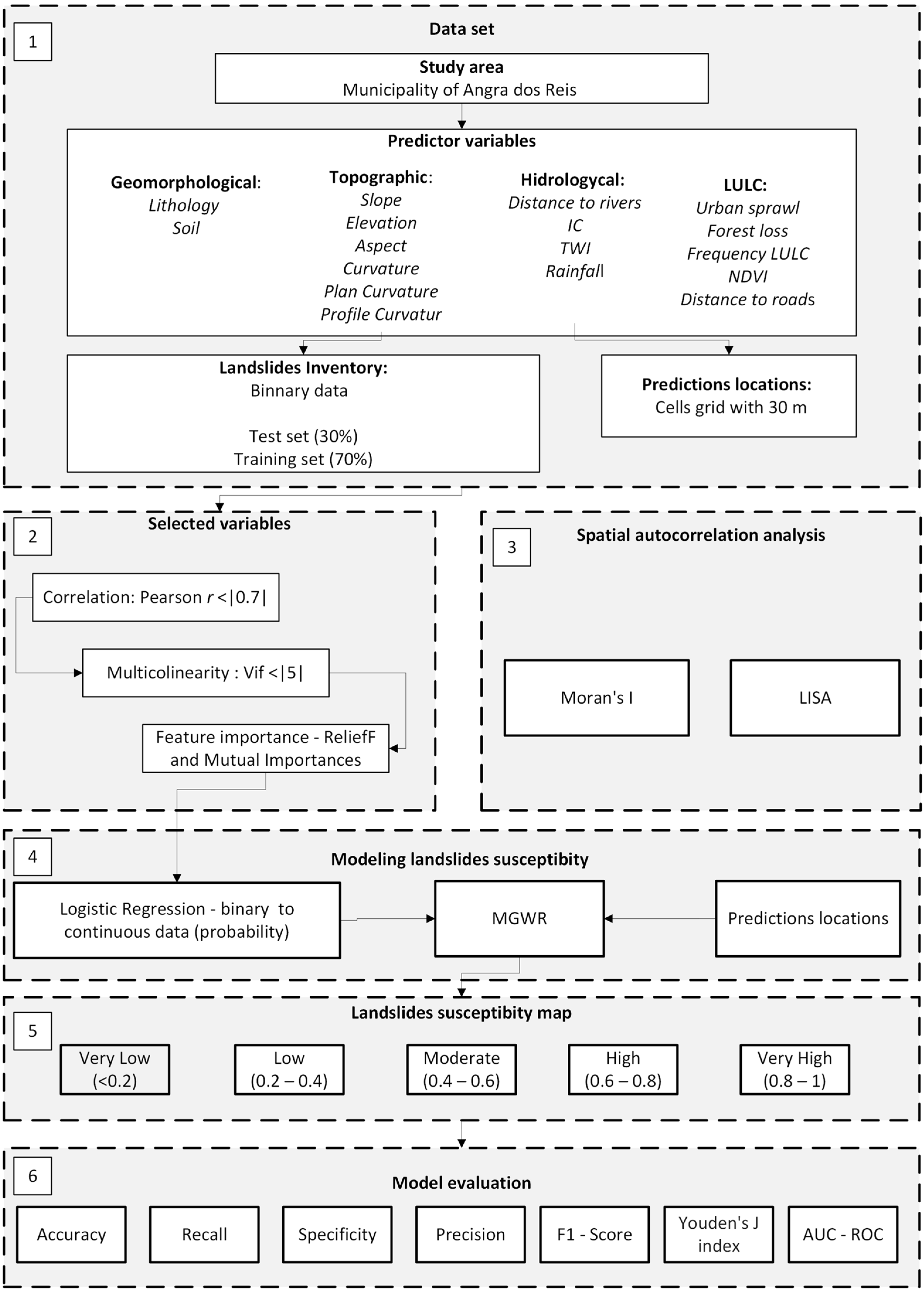


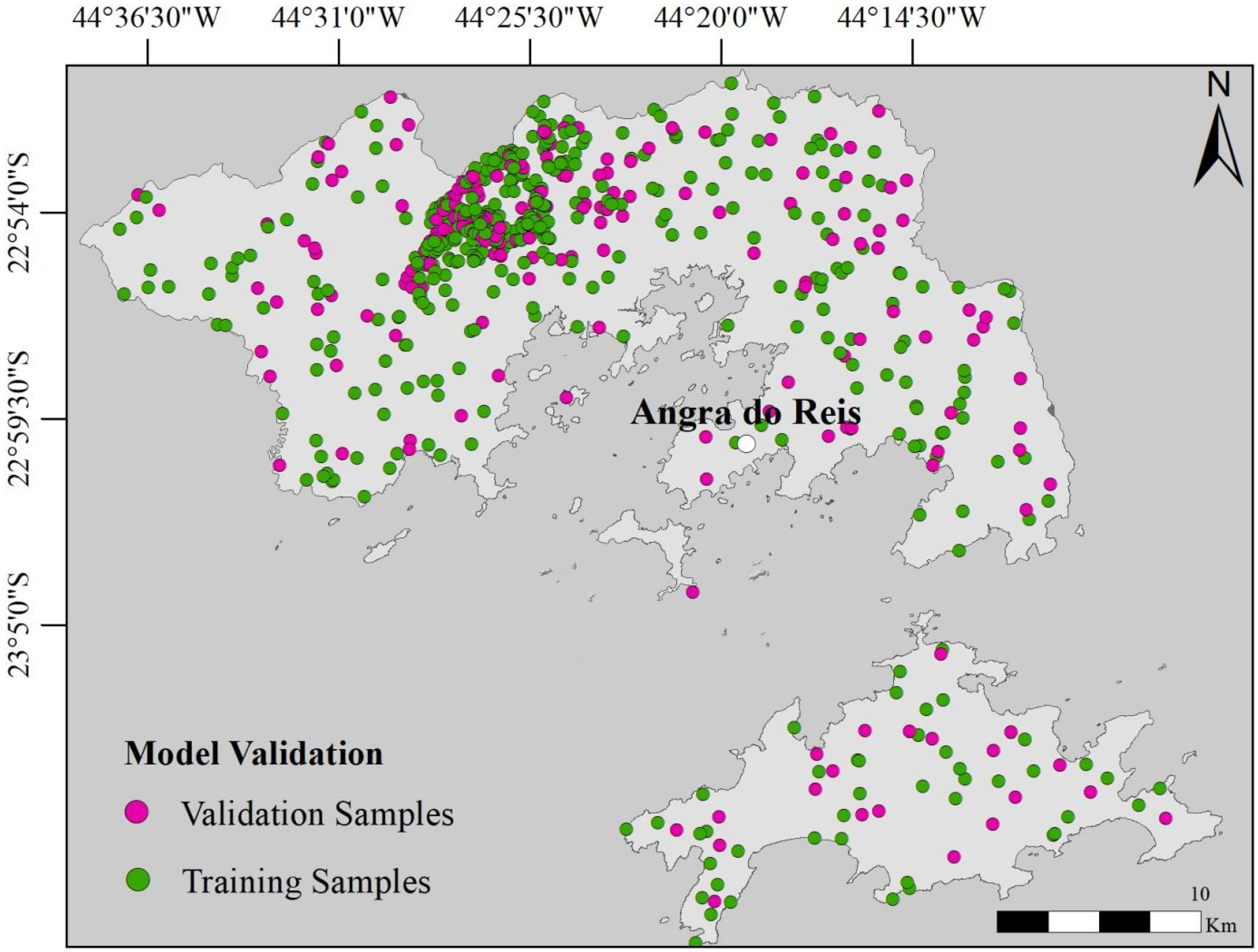
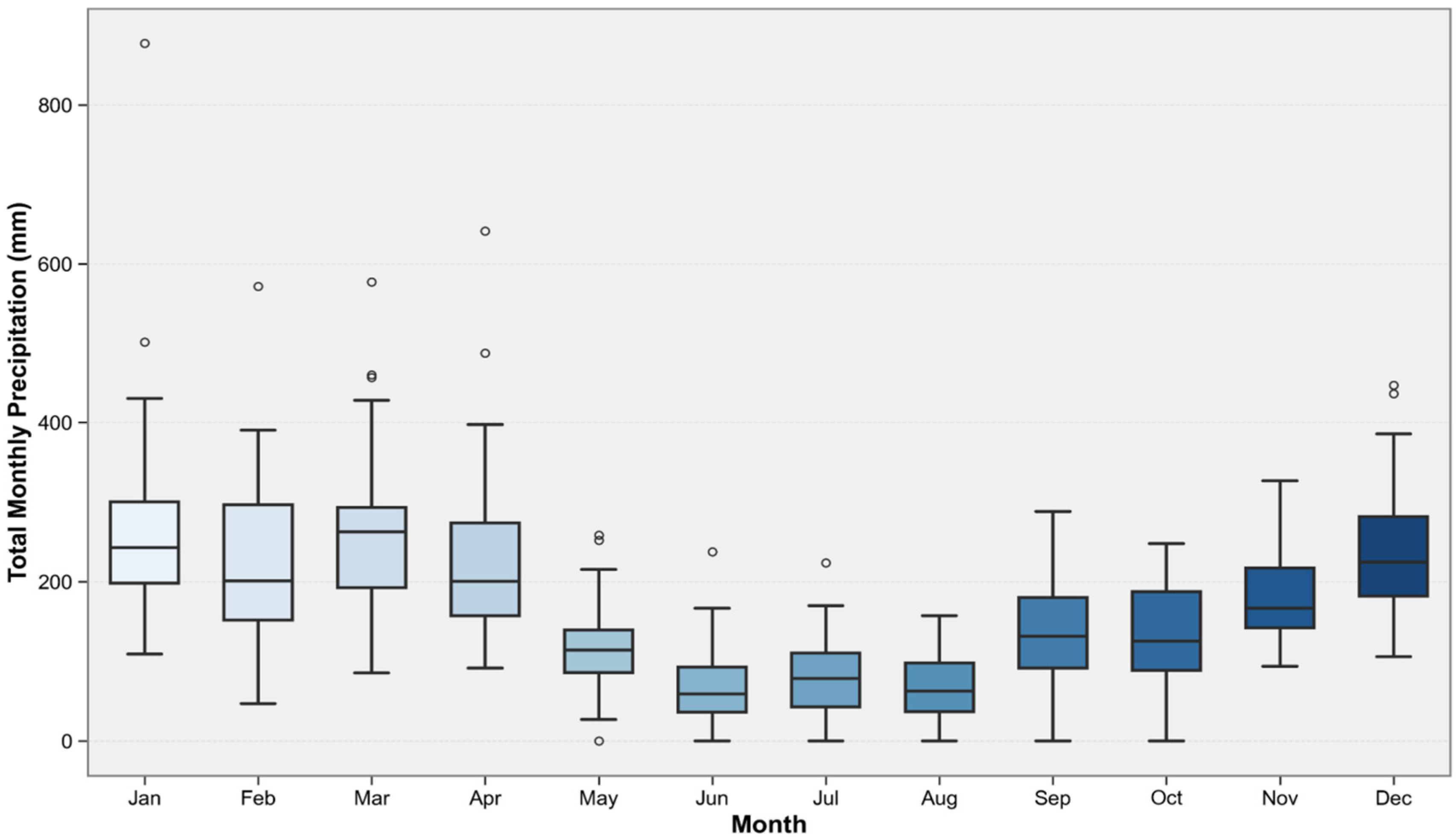




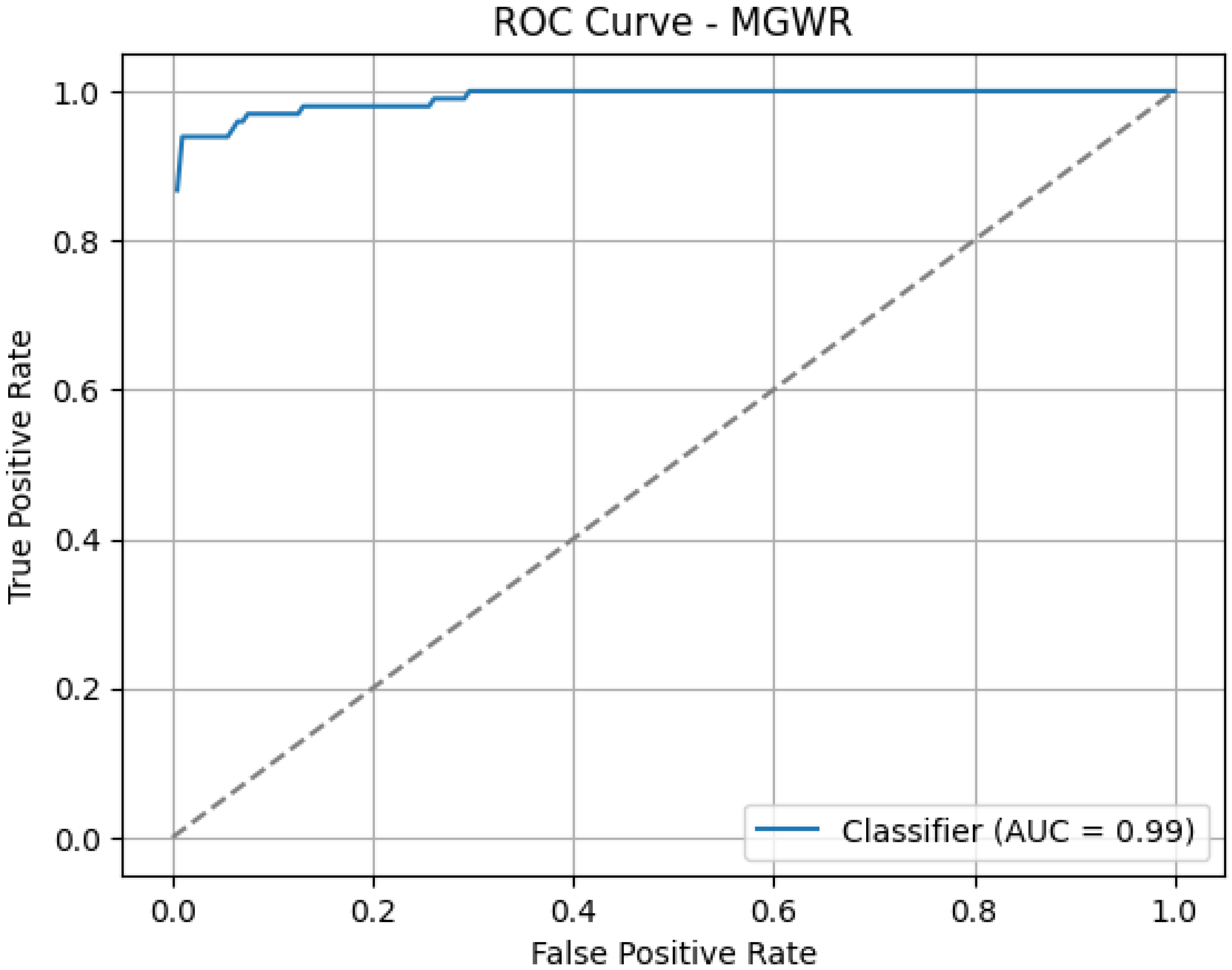
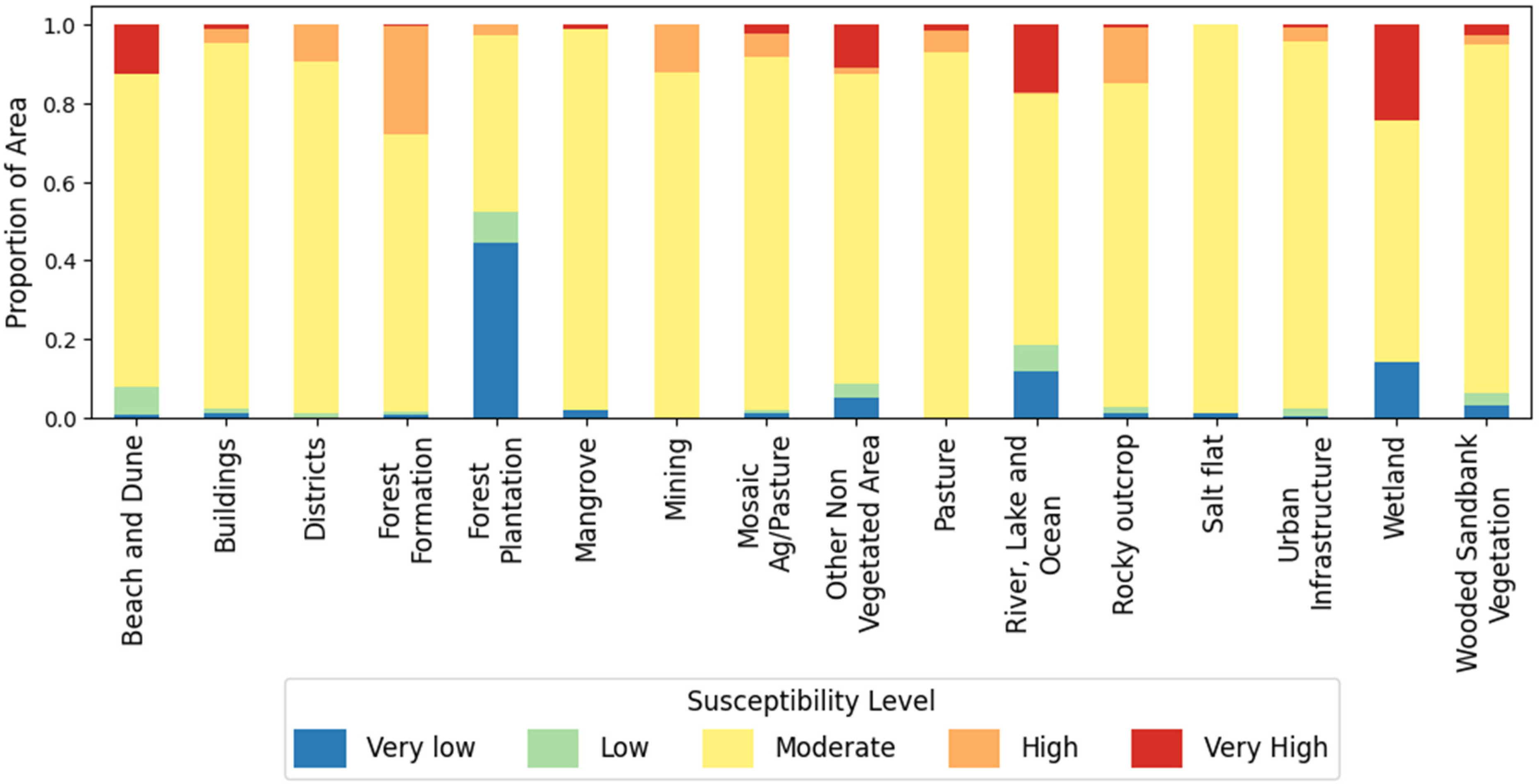
| Factors | Variable | Description | Resolution | Source |
|---|---|---|---|---|
| Geological | Lithology | Frequency ratio of lithotypes, indicating which rock types are more prone to landslides relative to their extent in the study area. | 1:100,000 | [24] |
| Soil | Frequency ratio of soil types, identifying which soil types are more susceptible to landslides. | |||
| Topographic | Slope | Slope gradient, where steeper slopes are more prone to landslides due to gravitational forces acting on the soil and rock. | 10 m | Sentinel-1 SAR (ESA) |
| Elevation | Height above sea level, influencing microclimatic conditions, vegetation cover, and erosion processes that affect slope stability. | |||
| Aspect | Frequency ratio for slope aspect, indicating the orientation’s relative landslide occurrence, evaluating how aspect influences landslide risk. | |||
| Curvature | Overall curvature of the terrain, affecting water flow concentration. Concave areas are more susceptible to landslides [27]. | |||
| Plan curvature | Horizontal curvature, indicating the potential for water convergence or divergence on slopes, impacting erosion rates. | |||
| Profile curvature | Vertical curvature, reflecting changes in slope that influence water velocity and erosion potential along the slope [28]. | |||
| Hydrological | Distance to rivers | Euclidean distance to the nearest river, where proximity may increase saturation and instability of slopes during heavy rainfall. | 10 m | Sentinel-1 SAR (ESA) |
| IC | The Index of Connectivity (IC) quantifies the potential for sediment transfer from slopes to drainage networks, improving spatial risk assessments by identifying areas where mobilized material is more likely to reach streams [29]. | 10 m | [30] | |
| TWI | Topographic Wetness Index, representing areas with higher potential for water accumulation, which can reduce slope stability [16,31]. | 10 m | (Sentinel-1 SAR (ESA) | |
| Rainfall | Annual total precipitation in wet days, with higher values indicating increased water input that can saturate soils and trigger landslides. | 0.05° | CHIRPS (Climate Engine) | |
| Land use and land cover | Urban Sprawl | Percentage increase in urban sprawl from the previous year, which can disturb natural drainage and slope conditions, enhancing landslide risk [32]. | 30 m | MapBiomas Project |
| Forest loss | Percentage of forest loss compared to the previous year, where deforestation can reduce slope stability and increase erosion potential [33]. | |||
| LULC | Frequency ratio for different land use and land cover types, revealing how certain land cover types might contribute to or mitigate landslide occurrences [34]. | |||
| NDVI | Normalized Difference Vegetation Index, indicating vegetation health and density, which contributes to slope stabilization and protection against erosion [33]. | 30 m | Google Earth Engine | |
| Distance to roads | Euclidean distance to the nearest road, where proximity may increase saturation and instability of slopes [35]. | 30 m | Open Street Map | |
| Distance to buildings | Euclidean distance to buildings, relevant for representing urban occupation within potential landslide impact zones [36]. | 30 m | Open Street Map |
| Variable | Class | Frequency Ratio |
|---|---|---|
| Lithology | Sand, Clay, Silt | 0.6109 |
| Mylonitic Gneiss, Metamark, Gneissic Granite | 2.9622 | |
| Granite | 0.2794 | |
| Soil Type | Cambisol—CX | 0.4401 |
| Red-yellow Latosol—LVA | 0.1082 | |
| Litholic Neosol—RL | 4.7201 | |
| LULC | Forest | 1.1962 |
| Mosaic | 0.3827 | |
| Aspect Orientation | North | 0.9779 |
| Northeast | 1.3216 | |
| East | 1.6917 | |
| Southeast | 1.5569 | |
| South | 1.0262 | |
| Southwest | 0.2500 | |
| West | 0.3270 | |
| Northwest | 0.4725 | |
| Flat/no defined aspect | 1.8093 |
| Statistic | MGWR |
|---|---|
| R-Squared | 0.9357 |
| Adjusted R-Squared | 0.9289 |
| AICc | 134.9961 |
| Sigma-Squared | 0.0711 |
| Sigma-Squared (MLE) | 0.0643 |
| Effective Degrees of Freedom | 390.4722 |
| Explanatory Variable | Optimal Bandwidth (m) | % of Extent | % Significant |
|---|---|---|---|
| Intercept | 16,263.02 | 24.50% | 100.00% |
| Elevation | 16,263.02 | 24.50% | 16.20% |
| Forest loss | 16,263.02 | 24.50% | 13.66% |
| FR—Lithology | 16,263.02 | 24.50% | 97.92% |
| FR—LULC | 16,263.02 | 24.50% | 0.69% |
| IC | 16,263.02 | 24.50% | 45.83% |
| NDVI | 28,091.04 | 42.33% | 78.94% |
| Profile curvature | 16,263.02 | 24.50% | 54.40% |
| Rainfall | 16,263.02 | 24.50% | 82.87% |
| Rivers distance | 32,608.94 | 49.13% | 0.00% |
| Roads distance | 66,367.31 | 100.00% | 100.00% |
| Slope | 23,861.64 | 35.95% | 75.93% |
| TWI | 47,229.17 | 71.16% | 0.00% |
Disclaimer/Publisher’s Note: The statements, opinions and data contained in all publications are solely those of the individual author(s) and contributor(s) and not of MDPI and/or the editor(s). MDPI and/or the editor(s) disclaim responsibility for any injury to people or property resulting from any ideas, methods, instructions or products referred to in the content. |
© 2025 by the authors. Licensee MDPI, Basel, Switzerland. This article is an open access article distributed under the terms and conditions of the Creative Commons Attribution (CC BY) license (https://creativecommons.org/licenses/by/4.0/).
Share and Cite
de Lara Maia, A.C.; Ayres, A.L.d.S.M.; Kanai, C.S.; da Silva Ferreira, J.; Fontes, M.R.; Desani, N.M.; Guimarães, Y.C.; de Praga Baião, C.F.; Mantovani, J.R.; Nery, T.D.; et al. Scale-Dependent Controls on Landslide Susceptibility in Angra dos Reis (Brazil) Revealed by Spatial Regression and Autocorrelation Analyses. Geomatics 2025, 5, 49. https://doi.org/10.3390/geomatics5040049
de Lara Maia AC, Ayres ALdSM, Kanai CS, da Silva Ferreira J, Fontes MR, Desani NM, Guimarães YC, de Praga Baião CF, Mantovani JR, Nery TD, et al. Scale-Dependent Controls on Landslide Susceptibility in Angra dos Reis (Brazil) Revealed by Spatial Regression and Autocorrelation Analyses. Geomatics. 2025; 5(4):49. https://doi.org/10.3390/geomatics5040049
Chicago/Turabian Stylede Lara Maia, Ana Clara, André Luiz dos Santos Monte Ayres, Cristhy Satie Kanai, Jamille da Silva Ferreira, Miguel Reis Fontes, Nathalia Moraes Desani, Yasmim Carvalho Guimarães, Cheila Flávia de Praga Baião, José Roberto Mantovani, Tulius Dias Nery, and et al. 2025. "Scale-Dependent Controls on Landslide Susceptibility in Angra dos Reis (Brazil) Revealed by Spatial Regression and Autocorrelation Analyses" Geomatics 5, no. 4: 49. https://doi.org/10.3390/geomatics5040049
APA Stylede Lara Maia, A. C., Ayres, A. L. d. S. M., Kanai, C. S., da Silva Ferreira, J., Fontes, M. R., Desani, N. M., Guimarães, Y. C., de Praga Baião, C. F., Mantovani, J. R., Nery, T. D., Marengo, J. A., & Alcântara, E. (2025). Scale-Dependent Controls on Landslide Susceptibility in Angra dos Reis (Brazil) Revealed by Spatial Regression and Autocorrelation Analyses. Geomatics, 5(4), 49. https://doi.org/10.3390/geomatics5040049








